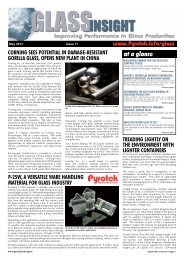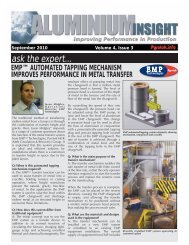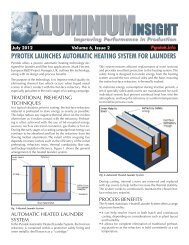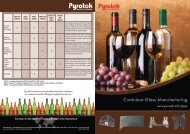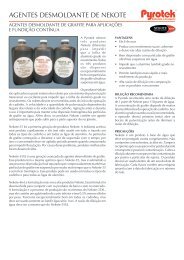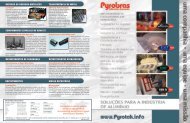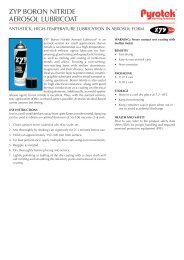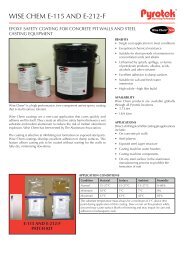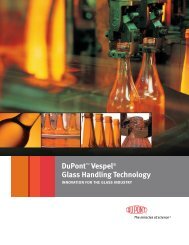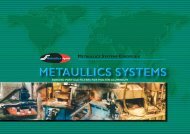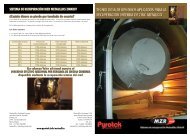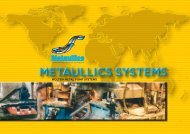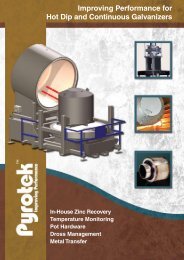Improving Performance - Billet Casting Improving ... - Pyrotek
Improving Performance - Billet Casting Improving ... - Pyrotek
Improving Performance - Billet Casting Improving ... - Pyrotek
You also want an ePaper? Increase the reach of your titles
YUMPU automatically turns print PDFs into web optimized ePapers that Google loves.
<strong>Improving</strong> <strong>Performance</strong> - <strong>Billet</strong> <strong>Casting</strong><br />
Figure 1a - Horizontal Direct Chill <strong>Casting</strong><br />
Figure 1b - Verticle Direct Chill <strong>Casting</strong> (picture courtesy of Wagstaff)<br />
overall consumption and greatly reduce the<br />
need for expensive chemical treatment of<br />
closed cooling water systems for the casting<br />
pits.<br />
Several aluminium casthouses, for a variety<br />
of reasons, are still confidently casting billet<br />
using the traditional conventional mould<br />
set-up, requiring a distributor basin, spouts,<br />
floats and pins. As I have mentioned before,<br />
billet casting needs to produce a product that<br />
meets or exceeds the customer’s expectations.<br />
This does not mean that the latest casting<br />
technology is either essential or even<br />
applicable to all billet casting operations. For<br />
these customers, <strong>Pyrotek</strong> supplies a variety<br />
of machined parts for spouts, pins and floats.<br />
Usually each of these is designed to fit the<br />
customer’s particular billet diameters and<br />
metal pouring conditions.<br />
Please refer to <strong>Pyrotek</strong>’s web-site for further<br />
details of our entire range of billet casting<br />
products and technical support staff who are<br />
available to assist – www.pyrotek.info.<br />
HiSTORY OF BiLLET CASTing<br />
Aluminium VDC billet casting is the process<br />
whereby molten aluminium is<br />
converted into a round ingot<br />
or billet. Although the process<br />
itself is rather straightforward,<br />
there are many variables during<br />
casting affecting the quality of<br />
the billet. Today there are two<br />
basic processes for converting<br />
molten aluminium into billet:<br />
Horizontal Direct Chill (HDC)<br />
and Vertical Direct Chill (VDC)<br />
(see Figures 1a, 1b). Each of<br />
these processes has it’s own<br />
distinct advantages. Since the<br />
output of the VDC process is<br />
by far the most widely utilised,<br />
it is therefore the focus of this<br />
article.<br />
Before the VDC process was<br />
developed, aluminium wrought<br />
billets were cast using the<br />
tilt mould ingot process. The<br />
molten aluminium was poured<br />
from a crucible into a watercooled<br />
book-mould tilted at an<br />
anglefromthehorizontal.When<br />
the aluminium in the mould<br />
reached the<br />
upper lip, it was tilted at<br />
a controlled rate until it<br />
was vertical. The tilt mould<br />
ingot was not suitable,<br />
however, for large diameter<br />
production and was limited<br />
to non heat-treatable alloys<br />
such as 1100 and 3003<br />
pyrotek<br />
supplement<br />
Alan Sale<br />
global <strong>Billet</strong> <strong>Casting</strong><br />
Specialist<br />
<strong>Billet</strong> casting<br />
needs to<br />
produce a<br />
product that<br />
meets or<br />
exceeds the<br />
customer’s<br />
expectations.<br />
For these<br />
customers,<br />
<strong>Pyrotek</strong> supplies<br />
a variety of<br />
machined parts<br />
for spouts, pins<br />
and floats.<br />
(see Figure 2). As demand Figure 2 - <strong>Casting</strong> Aluminium in a Tilt Mould<br />
for higher productivity<br />
coupled with the need for larger billets and<br />
high strength alloys increased, the VDC<br />
casting process replaced tilt mould casting in<br />
the 1930’s.<br />
Page 3



